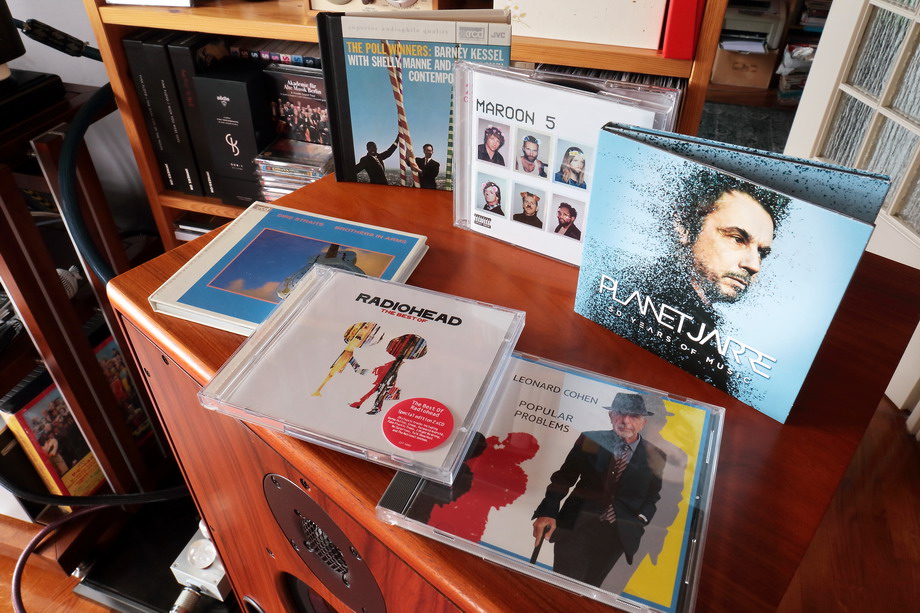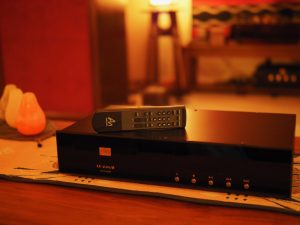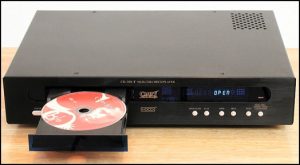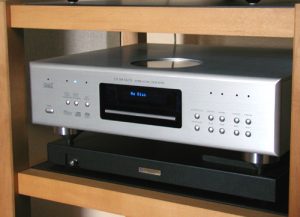CAMBRIDGE AUDIO is a British company specializing in audio and audio-video electronic components, whose distinctive feature is a particularly good value for money of their products. The Edge anniversary series launched a year ago seemed to change this approach. And yet... Cambridge Audio has just launched a new, cheapest AX series. Designed in the UK by its engineers, it uses innovative techniques sourced from the higher CX and Edge series. For this review we received the Compact Disc player, the AXC35.
Although it is hard to believe, the Cambridge Audio AXC35 Compact Disc player costing less than PLN 1500 is the more expensive of the two players in the new XA series from this manufacturer. Below in the price list you can find another model, the AXC25, for PLN 1090 (all prices in Poland). Both belong to the latest and cheapest XA series:
Today Cambridge Audio introduces the AX series, a brand new range of hi-fi separates. Designed and engineered in the UK, AX has something to offer every music lover, hitting the perfect balance between performance and affordability.
Consisting of a CD player, an integrated amplifier and two stereo receivers, the AX range takes design and innovation cues from Cambridge Audio's CX and Edge hi-fi ranges. Like those award-winning products, it uses the company's 50-plus years of audio engineering expertise to deliver what Cambridge Audio has dubbed its "Great British Sound", a pure, unfiltered audio experience reflecting the artist's intentions—nothing added, nothing taken away.
source: Cambridge Audio, press release, June 5th 2019
There are four levels in this series: 25, 35, 85i 100. The 25 includes the AXA25 integrated amplifiers and the AXC25 Compact Disc Player, than there is the AXA35 integrated and AXC35 CD Player, and two stereo receivers, the AXR85 and AXR100.
Although it may seem that budget devices are the easiest to design and sell, in reality it is completely different. If we are dealing with a specialist company and not a big concern, which is exactly the case of Cambridge Audio, the device must meet many pre-conditions, without which the company would not sell them with its logo. And that means costs—good sound always costs, regardless of what price range we are talking about. And if we increase the costs, we have to calculate the final price very carefully and balance everything so that it makes sense to make and sell such device and at the same time to offer a good sound.
By introducing new devices Cambridge Audio did seemingly impossible: they managed to keep the price from ten or even fifteen years ago. Because, let me remind you, the offer of budget audio components was divided into several price categories, used also by specialist magazines. First, there was a range of up to around PLN 1000, then from PLN 1000 to 2000, then from PLN 2000 to 4000, etc. I don't know how they did it, but it worked—AXC25 belongs to the first category if we turn a blind eye to 90PLN, and the AXC35 would be exactly in the middle of the second one.
It's not every day that entry level devices hit the market—at least not in present times. The introduction of the XA series is therefore an important event that—hopefully!—will initiate a similar trend for other manufacturers who have not yet lost themselves in the price madness. So I took the opportunity and invited two Cambridge Audio sales managers, Mr. Steven Bowers (Head of EMEA Sales) and Pete Dixon (International Sales Manager) to my place. We had enough time to talk about the new series and listen to music—using the AXC35.
A few simple words…
STEVEN BOWERS PETE DIXON
Cambridge Audio
Steven Bowers (closer) and Pete Dixon in front of the High Fidelity reference system
WOJCIECH PACUŁA: XA is a brand new, affordable series. It's not easy to develop such product—how did you manage it?
STEVEN BOWERS: Well, a lot of the costs of developing the AX series have been saved, because to some extent it is a series based on the older Topaz series, that included CD5 and CD10 players. Above, there was the Azur series, but—as you said—the production costs at that time significantly increased, which caused us to lose money.
The days when many inexpensive devices were sold are gone, but something started to change about four years ago. We also did. We focused on what we call the Great British Sound and turned directly to people who love music, to audiophiles.
At the same time home cinema died, didn't it?
(Laughing) Almost completely, it was a dead end. We can talk about it someday, but now it is enough to say that it actually ceased to interest us for several reasons. First of all, because everyone at Cambridge is a true music fan. When you look at the back of our business cards, you will see that each of us has our favorite tracks named there (in Steven's case it was Deadmous and I Remember (Vocal Mix) - ed.). Almost all engineers in London play some instrument and we even have our own band. So we can say that we are audiophiles and music fans.
So which instruments do you play?
No, we don't play any…
And you said all of you did.
(Laughing) Not exactly—I was talking about engineers, we prefer to listen to the music.
PETE DIXON: Let's say that we appreciate others playing music and do not want to spoil it. Anyway, the AX series was a result of such thinking. We think it's a good way to enter the hi-fi world, to start your adventure with music. Of course, it can be done by listening to music using Bluetooth speakers, such as YoYo, from a smartphone, but we wanted to show people that it can be done much better, and that you can experience music in a deeper way. That is why it is very important for us to have such an affordable series in our offer.
SB: In the last few years, we've also changed, to some extent, the way the devices are designed, which accumulated in the Edge series, which you probably know. One of the external manifestations is the Luna Gray finish, which we introduced with it. It took us two or three years to develop it, and the engineers had no restrictions—we said they were to prepare devices that they would like to have at homes themselves. So they spent a lot of time on research, and the results of their work were also used in the AX series. Based on this work, we want to go further and replace the CX series in the near future, which will also be available in Luna Gray.
I have to admit that I love this color. Just have a look how good your product look in a company of much more expensive components in my system.
I totally agree. We wanted all our products to have a common feature, something that can be described as "Cambridge Look." Everything is thought out here—the place where the name is, the arrangement of buttons, the whole form. Description of the artistic project takes over 150 A4 pages... So we are trying to "internally" unify our entire lineup, and at the same time keep an attractive pricing, so that people who are just entering the hi-fi world can afford them—whether it is a phono stage, amplifier, or even a CD player—still a lot of people have lots of CDs.
That's right—is it why you have decided to prepare a CD Player, or actually two of them?—Even though we live in a "streaming era," right?
Sales of CDs are decreasing, that's right, in favor of streaming. But also many people still have large collections of CDs. Anyway, I'm a good example of how it works now. I listen to most of the music using streaming—through Spotify or Tidal—but when I really like an album, I buy it on CD or vinyl, I want to have it in physical form. There is also a lot of music that is not available in streaming services. In addition, many people have secondary systems in their offices and often listen to CDs there.
PD: Let me remind you of the CXC series, that also includes a CD transport. When the series entered the market, we had only a 50% chance that transport would sell, no one in the company knew how the market would react to this device. It turned out that its sales increase every year. As you can see, people still want to listen to Compact Discs.
What are company's future plans?
SB: We have been changing the direction for some time. Earlier, we operated as a classic company of this type—we introduced new products regularly, every six months. The new versions had a slightly changed appearance, different functionality, slightly improved sound. Now we want to slow down a bit and we will offer less products. We want to offer devices that respond to the needs of customers—we want to be close to them. Thanks to this, we will be able to focus more on quality.
One more question—do you plan to add a streamer to the AX series?
We have been talking about it, even have made some plans, but we still have to deal with several issues. I think the streamer will be introduces to the market later this year. And it won't be expensive.
AXC35
Although inexpensive, the new player looks very nice, stylish. Its front panel is made of aluminum and anodized to the color that Cambridge calls "Lunar Gray." The sides, top and bottom are painted black—these elements are made of steel. Giving up two traditional front colors—black and silver—may seem unnecessary, but—that's my opinion—gray rules!
The device has a classic look for Compact Disc players from, say, ten years ago. In the middle there is a disc drawer and below there is a display. The latter is not very legible and you will not find information about the repeat and random modes being turned on. But this is an element where they could save some money in order to invest it elsewhere. On the side there are the drive control buttons, and on the left the standby button with a white micro LED in the middle. The front is made in such a way that there are no feet there, and the device rests on a fragment of the front panel —an element borrowed from the more expensive CX series.
I have already mentioned that the Player features a classic drive here, not a slot one - this is a conscious choice of the Cambridge Audio engineers. It is a transport optimized to work with CD-DAs (Compact Discs), but which also allows you to play also CD-Rs with WMA and mp3 files. However, do not expect CD-Tex. It's a "gapless" player, which means it is able to play music constantly (without dividing it to individual tracks), which will be useful, for example, when listening to concerts and compilations.
The player features a stereo RCA analog output as well as a RCA digital output, their sockets are not gold-plated. There aren't any digital inputs. Some money was also saved by using an "eight" power socket, not IEC. In accordance with the latest guidelines of the European Commission, this is a low power consumption device, because after some time without an output signal, it automatically "standby," and in this mode it consumes less than 0.5 W. The remote control is another stop for an accountant, so do not expect fireworks. But it is not bad either—it is a system remote control in which the buttons controlling the drive are quite sensibly placed.
HOW WE LISTENED TO IT
The AXC35 player, although inexpensive, should be treated seriously—it is a specialized product, for people who have broken free from the smartphone bubble. So it was tested like any other audio component, i.e. in the High Fidelity reference system, and compared to reference player—Ayon Audio CD-35 HF Edition (№ 1/50), costing 80,000 PLN. But apart from it I also listened to the twice as expensive Pro-Ject CD Box DS2 player and the CD/audio files player Primare CD15 Prisma.
I also tested the AXC35 by using it to deliver digital signal to the Mytek Brooklyn Bridge. The Player was powered using the Hijiri SM2R "Sound Matter", using a proper adapter, I also placed Verictum X Block passive EMI/RFI filter on top of it.
SOUND
Recordings
- Audiophile Reference IV, First Impression Music FIM029 VD, HDCD (2005)
- Dire Straits, Brothers in Arms, Vertigo/Universal Music Ltd. Hong Kong 5483572, XRCD2 (1985/2000); a comparison of different remasters, see HERE
- Fisz Emade Tworzywo, Numer 1, Art2 Music 5902860140665, 2 x CD (2018)
- Jean-Michel Jarre, Planet Jarre. 50 Years Of Music, Columbia Sony Music Entertainment Germany 5833792, 2 x CD (2018); review HERE
- Leonard Cohen, Popular Problems, Sony Music Labels SICP-4329, CD (2014); review HERE
- Maroon 5, Red Pill Blues, 222 Records/Interscope 6705300, 2 x CD (2017)
- Radiohead, The Best Of, Parlophone EMI Records 227 5882, 2 x CD (2008)
- The Poll Winners, The Poll Winners, Contemporary Records/JVC JVCXR-0019-2, XRCD (1957/1988)
Taking advantage of the fact that I had people from Cambridge Audio at home, I offered them a listening session with their player in the HF reference system. First we listened to a dozen or so tracks using AXC35 only, and then compared them with how they sounded from the Ayon Audio CD-35 HF Edition player. I must say that we had a good time. After finishing I asked both gentlemen for a short comments.
Cambridge Audio & Cambridge Audio
PETE DIXON Although our player costs a fraction of what the whole system costs, I am very happy with what I heard with the AXC35. I didn't pay so much attention to the difference between our player and Ayon for 20,000 euros, because our player just sounded really nicely. There was not such a huge difference between these two, it wasn't at all like listening to AXC35 was unbearable—on the contrary, our player sounded really well in such a unique system. Which makes me very happy.
STEVEN BOWERS Our player did really well, I agree with Pete. It fits well with the rest of the system, even though it's not at the same level or even close. You can't really expect that such an inexpensive device as the AXC35 will offer a similar level of performance as the Ayon, but this it was really good one, I am very happy. This is not a system that will be offered in an audio store to a customer with our player. But it really sounds good! And you could hear how important the role of the source in the system is—what you get at the beginning is then only processed. If the CD player does not properly read information from the disc, then it can't be repaired in following components.
PD: We usually listened to this player combined with other components from the AX series, sometimes with the CX series, that's why it's a great pleasure for us to listen to it in such an environment. And even bigger one, because it sounded so well.
Cambridge Audio and me
Knowing price of the English player, it can be easy to throw it into a "whatever" compartment. But think again—this is a device prepared by a specialist who knows what he;s doing, and it was prepared in times when there are new CD players are a rarity. And this means that they cannot hide behind the backs of others and they must face the challenges themselves. What's more, they also have to face music played from computers.
Knowing this, I took his test absolutely seriously, the same as the tests of players costing 50,000 or even 100,000 PLN. It was both about the appropriate test methodology and my expectations. It is good that I did so, because I learned quite a lot about how the evolution of digital audio players, mainly file players, has affected the world of physical media.
The AXC35's sound is open, dynamic and powerful. This is full-blooded, powerful presentation. The player does not hide details, does not try to influence emotions by appealing to the romantic side of a listener, but simply delivers music in a neutral and uncolored way. It seems that it is about showing as much information as possible in the most orderly way possible.
The tonal balance of the device is set so as not to add too much or subtract too much, which would confirm the comments from the manufacturer's press release. It is not exactly so, because the both extremes of the band are slightly favored, but this is not clear and with little effort, say selection of slightly warmer speakers and cables, this feature can be offset. But you don't have to do it, it can be left as it is, because due to it the sound is so open and dynamic. And the dynamics is really great, which I heard with the Dire Straits Brothers in Arms album, with the Red Pill Blues by Maroon 5, as well as with the Jean-Michel Jarre's Planet Jarre.
Fortunately, this is not a particularly emphatic sound. Compared to the reference player, it could be heard that the attack is rounded and some part of the midrange withdrawn. But this is normal, it comes with resolution, which for that money simply has to be limited. In turn, the selectivity is excellent—this is something that many music fans will appreciate. Individual instruments could be heard, there were separate layers of the stage, nothing melted together, nothing was not masked—at least not more than I expected.
AXC35 as a CD transport
After the introduction of the Compact Disc format in 1982, for many years CD players were integrated devices with analog outputs. Everything changed in 1984, when Cambridge Audio introduced a four-box CD player with a separate transport and D/A converter. Soon, other companies proposed external D/A converters, and everyone began to equip their players with digital outputs. In this way, a completely new category of audio products was created.
AXC35 can also be upgraded by connecting an external DAC to it. It turns out that its drive is quite sensible and actually allows you to improve the sound. Combined with the Mytek Brooklyn Bridge DAC I received a detailed and clear sound with high dynamics—apparently these features come from the drive. There is not much saturation there, do not expect fireworks. But such a set can offer a decent, good sound and allow user to play any kind of music.
It was surprising how well the player differentiated recordings. You see, while preparing for this test, I tried to choose discs that aren't necessarily audiophile's dreams. I wanted to experience what people just starting their adventure with high quality sound have a chance to hear, I was looking for the sound they would find on ordinary CDs bought at Empik, found on sales and bought for pennies online. And ultimately I found myself listening to the best discs I had on hand... XRCDs , HQCD and Master CD-R.
This is because the Cambridge Audio player responds well to signal quality improvement—the better the recorded material, the better the release quality, the better it sounded. First of all, the tonality improved, now the more saturated and warmer, fuller. The treble was a bit weaker now, which made the presentation more vivid. With the AXC35 they are not annoying even with ordinary, highly compressed discs intended for listening in the car, like the aforementioned Maroon 5 or Jarre, but with good, jazz XRCD discs it was as if I had changed the player to twice as expensive one. And at the same time the high dynamics and nice, strong bass were still there.
Summary
This probably what this device will let you do—upgrade or improve the sound. The AXC35 allows it, and even encourages it, elevates the system's performance. In its basic function, it works great. We get an open, strong, spatial presentation with a slightly emphasized band's extremes. There will be no problems with bass, but it is worth paying attention to the treble—the system should not sound dry or clear. But over time, we'll start looking at higher quality CD releases—and that's good! The player will sound even better and we will not have to replace it with a more expensive one. This is good engineering! And that's the RED Fingerprint.
DESIGN
From the outside, the AXC35 player stands out for its modest elegance. It's an inexpensive device, we know it, and yet it doesn't seem "cheap." And this is due to the nice design and color scheme—I like the gray color of the front.
Most of the design features have already been discussed in the introduction, so let's just add information about what one finds inside. It turns out that there is a lot of space there, thanks to which the individual sections could be placed far apart, so they interfere less with each other.
Drive
The drive is located in the middle. It's a nice mechanism that Sony designed and used years ago. When the company gave up the production of full-size audio devices, it also abandoned the production of CD drives. Fortunately, after a short break, companies from Taiwan and China undertook the production and from there, I think, all the drives used by Cambridge Audio come from. The specimen in AXC35 was bolted not to the bottom part, but to the stiffening C-profiles.
The drive control circuit is placed on a single PCB together with a digital-to-analog converter section. It's a highly integrated system, custom made for Cambridge. The mechanics is a specialized CD drive, but thanks to the controller, DSP ALI M5671A1, it also decodes data from CD-Rs. And drive control occupies the largest part of the board.
DAC On the side you will find the D/A converter chip from Wolfson Microelectronics, model WM8524. It's a complete, inexpensive circuit that converts and amplifies the audio signal. It works with signals up to 24-bits and 192kHz, it also has a built-in I/U converter and analog filters with a buffer and a driver. Its output delivers a ready signal for the RCA output. The board is SMD except for capacitors, which are threaded.
Power supply Also the power supply was custom made for CA and especially for XA series CD players. This is a switched mode power supply with two separate power sections—for the drive and the audio section. There are a lot of filtering and voltage stabilizing circuits. All three sections are connected to each other using flat ribbons.
Technical specifications (according to the manufacturer)
- DAC: Wolfson Microelectronics WM8524
- Analog filter: 2-pole Butterworth
- THD (1 kHz, 0 dBF): <0.006%
- Frequency range: 20 Hz-20 kHz (+/-0.4 dB)
- Crosstalk: <-98 dB/1 kHz <-95 dB/20 kHz
- S/N: >93 dB
- Output impedance: <50 Ω
- Maximum power consumption: 15 W
- Standby power consumption: <0.5 W
- Dimensions (W x H x D): 430 x 75 x 305 mm
- Weight: 4.3 kg
Price (in Poland): 1490 PLN
CAMBRIDGE AUDIO
Gallery Court Hankey Place
London SE1 4BB
UNITED KINGDOM
https://www.cambridgeaudio.com
DESIGNED AND ENGINEERED IN GREAT BRITAIN
ASSEMBLED IN CHINA
Provided for test by AUDIO CENTER POLAND http://www.audiocenter.pl
Text: Wojciech Pacuła
Images: Cambridge Audio Wojciech Pacuła
Translation: Marek Dyba


















































